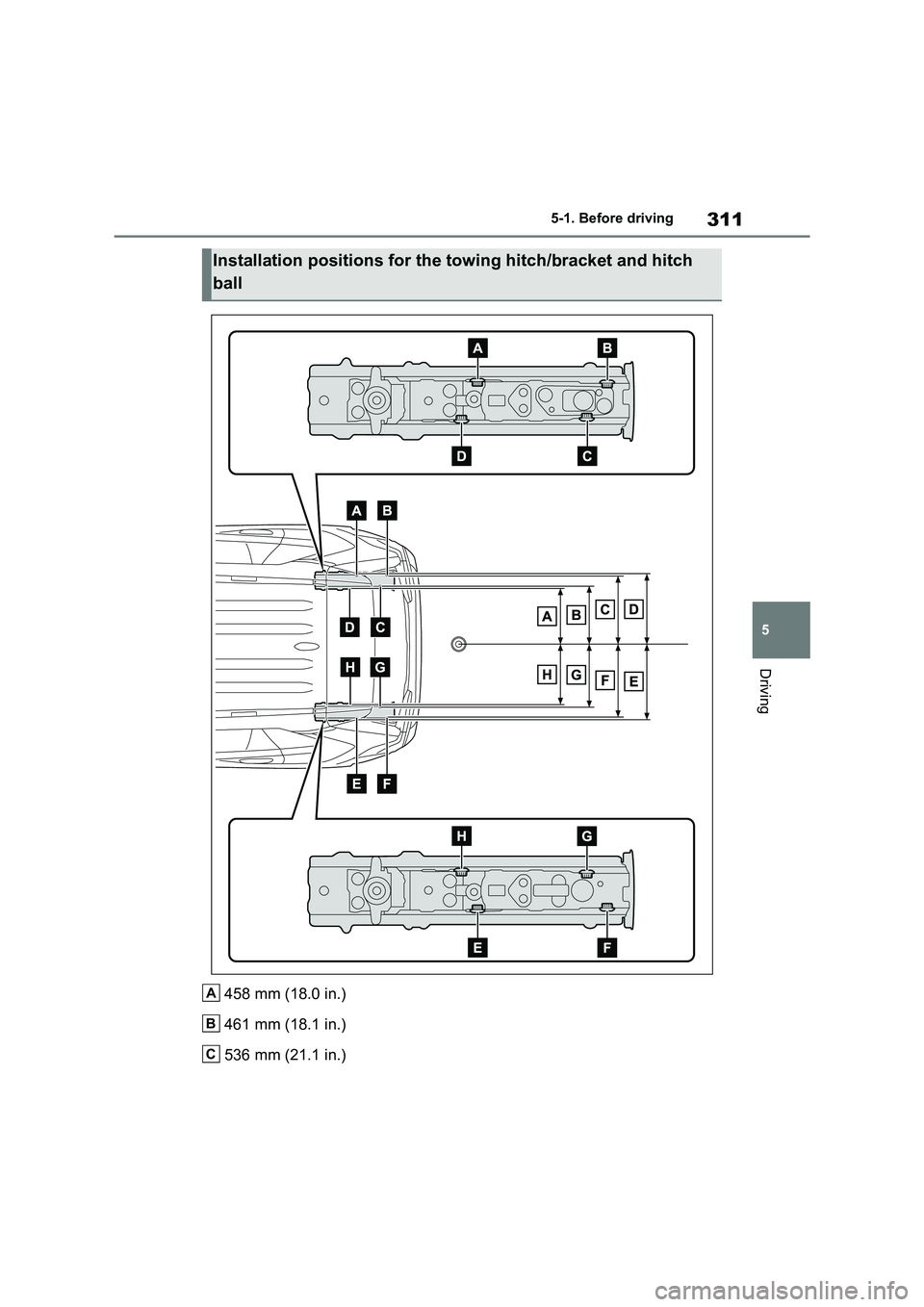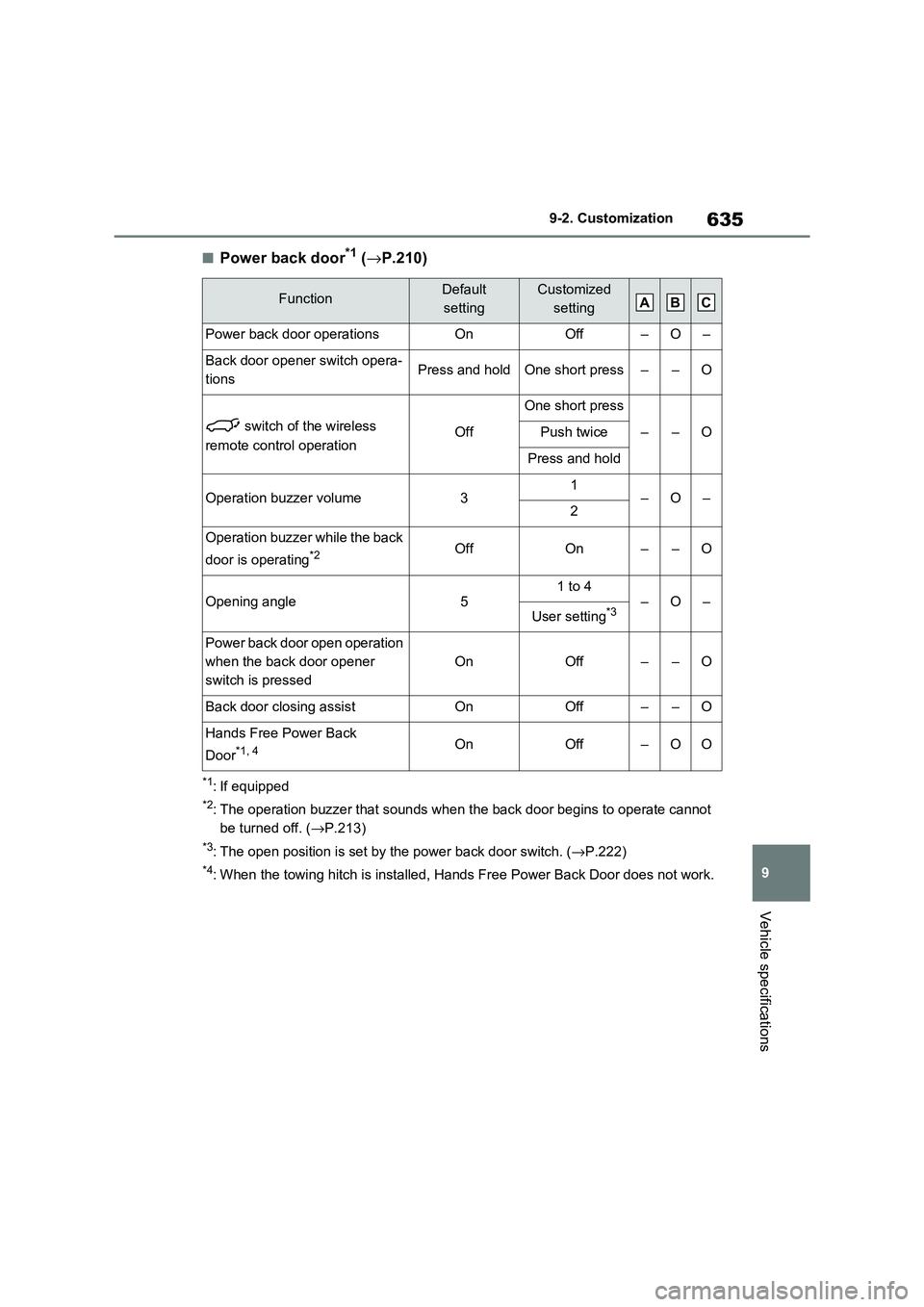2021 TOYOTA RAV4 PHEV hitch
[x] Cancel search: hitchPage 310 of 666

3085-1. Before driving
■Tire information
●Increase the tire inflation pressure to
20.0 kPa (0.2 kgf/cm2 or bar, 3 psi) greater than the recommended value
when towing. ( →P.624)
●Increase the air pressure of the trailer
tires in accordance with the total
trailer weight and according to the val - ues recommended by the manufac -
turer of your trailer.
■Safety checks before towing
●Check that the maximum load limit for
the towing hitch/bracket and hitch ball
is not exceeded. Bear in mind that the coupling weight of the trailer will add
to the load exerted on the vehicle.
Also make sure tha t the total load exerted on the vehi cle is within the
range of the weight limits. ( →P.309)
●Ensure that the trailer load is secure.
●Supplementary outside rear view mir- rors should be added to the vehicle if
the traffic behind c annot be clearly
seen with standard mirrors. Adjust the extending arms of these mirrors on
both sides of the vehicle so that they
always provide maxi mum visibility of the road behind.
Trailer towing
Your vehicle is designed pri -
marily as a passenger carry -
ing vehicle. Towing a trailer
will have an adverse effect on
handling, performance, brak -
ing, durability, and fuel con -
sumption. Your safety and
satisfaction depend on the
proper use of correct equip -
ment and cautious driving hab -
its. For your safety and the
safety of others, do not over -
load the vehicle or trailer.
To tow a trailer safely, use
extreme care and drive the
vehicle in accordance with the
trailer’s characteristics and
operating conditions.
Toyota warranties do not apply
to damage or malfunction
caused by towing a trailer for
commercial purposes.
Ask your local authorized
Toyota retailer or Toyota
authorized repairer, or any reli -
able repairer for further details
before towing, as there are
additional legal requirements
in some countries.
WARNING
Follow all the instructions described in
this section.
Failure to do so could cause an acci - dent resulting in death or serious
injury.
■Trailer towing precautions
When towing, make sure that none of
the weight limits are exceeded.
( →P.309)
■To avoid accident or injury
●Vehicles with compact spare tire: Do not tow a trailer when the com -
pact spare tire is installed on your
vehicle.
●Vehicles with emergency tire punc -
ture repair kit: Do not tow a traile r when the tire
installed is repa ired with the emer-
gency tire puncture repair kit.
Page 311 of 666

309
5
5-1. Before driving
Driving
Check the allowable towing capac -
ity, GVM (Gross Vehicle Mass),
MPAC (Maximum Permissible Axle
Capacity), and permissible drawbar
load before towing. ( →P.618)
Toyota recommends the use of the
Toyota hitch/bracke t for your vehi-
cle. Other products of a suitable
nature and comparable quality may
also be used.
For vehicles where the towing
device blocks any of the lights or
license plate, the fo llowing shall be
observed:
Do not use towing device that
cannot be easily removed or
repositioned.
Towing devices must be
removed or repositioned when
not in use.
Please consult a ny authorized
Toyota retailer or Toyota authorized
repairer, or any reliable repairer
when installing tra iler lights, as
incorrect installa tion may cause
damage to the vehicle’s lights.
Please take care to comply with
your state’s laws when installing
trailer lights.
■Total trailer weight and per -
missible drawbar load
Total trailer weight
WARNING
●Do not use dynamic radar cruise
control with full- speed range (if
equipped) or cruise control (if equipped) when trailer towing.
■Vehicle speed in towing
Observe the legal maximum speeds
for trailer towing.
■Before descending hills or long declines
Reduce speed and downshift. How -
ever, never downshift suddenly while descending steep or long downhill
grades.
■Operation of the brake pedal
Do not hold the brake pedal
depressed often or for long periods of time.
Doing so may result in the brake over -
heating or reduce braking effects.
Weight limits
Towing hitch/bracket
Connecting trailer lights
NOTICE
■Do not directly splice trailer lights
Directly splicing trailer lights may
damage your vehicle’s electrical sys - tem and cause a malfunction.
Important points regarding
trailer loads
A
Page 312 of 666

3105-1. Before driving
Weight of the trailer itself plus the trailer
load should be within the maximum
towing capacity. Exceeding this weight
is dangerous. ( →P.618)
When towing a trailer, use a friction
coupler or friction st abilizer (sway con-
trol device).
Permissible drawbar load
Allocate the trailer load so that the
drawbar load is g reater than 25 kg
(55.1 lb.) or 4% of the towing capacity.
Do not let the draw bar load exceed the
indicated weight. ( →P.618)
■Information tag (manufac-
turer’s label)
Gross vehicle mass
The combined weight of the driver, pas -
sengers, luggage, towing hitch, total
curb mass and drawbar load should not
exceed the gross vehicle mass by more
than 100 kg (220.5 lb.). Exceeding this
weight is dangerous.
Maximum permissible rear axle
capacity
The weight borne by the rear axle
should not exceed the maximum per -
missible rear axle capacity by 15% or
more. Exceeding this weight is danger -
ous.
The values for towing capacity were
derived from testing conducted at sea
level. Take note t hat hybrid system out-
put and towing capacity will be reduced
at high altitudes.
B
A
B
WARNING
■When the gross vehicle mass or
maximum permissible axle capacity is exceeded
Failing to observe this precaution may
lead to an accident causing death or
serious injury.
●Add an additional 20.0 kPa (0.2
kgf/cm2 or bar, 3 psi) to the recom -
mended tire inflation pressure
value. ( →P.624)
●Do not exceed the established
speed limit for towing a trailer in built-up areas or 100 km/h (62
mph), whichever is lower.
Page 313 of 666

311
5
5-1. Before driving
Driving
458 mm (18.0 in.)
461 mm (18.1 in.)
536 mm (21.1 in.)
Installation positions for the towing hitch/bracket and hitch
ball
A
B
C
Page 317 of 666

315
5
5-1. Before driving
Driving
■Sudden acceleration/steering
input/cornering
Executing sharp turns when towing
may result in the trailer colliding
with your vehicle. D ecelerate well in
advance when approaching turns
and take them slowly and carefully
to avoid sudden braking.
■Important points regarding
turning
The wheels of the tr ailer will travel
closer to the inside of the curve
than the wheels of the vehicle. To
make allowance for this, take the
turns wider than you would nor -
mally do.
■Important points regarding
stability
Vehicle movement resulting from
uneven road surfaces and strong
crosswinds will affect handling. The
vehicle may also be rocked by
passing buses or large trucks. Fre -
quently check behind when moving
alongside such vehicles. As soon
as such vehicle movement occurs,
immediately start to decelerate
smoothly by slowly applying the
brakes. Always steer the vehicle
straight ahead while braking.
■Passing other vehicles
Consider the total combined length
of your vehicle and trailer and
ensure that the vehicle-to-vehicle
distance is sufficient before execut -
ing lane changes.
■Transmission information
To maintain engine braking effi -
ciency, when using engine braking,
do not use the transmission in D.
( →P.321)
■If the hybrid system overheats
Towing a loaded trailer up a long,
steep incline in temperatures
exceeding 30°C (85°F) may result
in the hybrid system overheating. If
the high coolant temperature warn -
ing light indicates that the hybrid
system is overheating, turn the air
conditioning off immediately, leave
the road and stop the vehicle in a
safe place. ( →P.611)
■When parking the vehicle
Always place wheel chocks under
the wheels of both the vehicle and
trailer. Firmly set the parking brake
and shift the shift lever to P.
■Break-in schedule
Toyota recommends that vehicles fitted
with new power train components
should not be used for towing trailers for the first 800 km (500 miles).
■Maintenance
●Maintenance must be performed more frequently when using the vehicle for
towing due to the greater weight bur -
den placed on the vehicle compared to normal driving.
●Retighten all bolts securing the hitch - ing ball and bracket after towing for
approximately 1000 km (600 miles).
■If trailer sway occurs
One or more factor s (crosswinds, pass- ing vehicles, rough roads, etc.) can
adversely affect handling of your vehicle
and trailer, causing instability.
Page 637 of 666

635
9
9-2. Customization
Vehicle specifications
■Power back door*1 ( →P.210)
*1: If equipped
*2: The operation buzzer that sounds when the back door begins to operate cannot
be turned off. ( →P.213)
*3: The open position is set by the power back door switch. (→P.222)
*4: When the towing hitch is installed, Hands Free Power Back Door does not work.
FunctionDefault
setting
Customized
setting
Power back door operationsOnOff–O–
Back door opener switch opera -
tionsPress and holdOne short press––O
switch of the wireless
remote control operationOff
One short press
––OPush twice
Press and hold
Operation buzzer volume31–O–2
Operation buzzer while the back
door is operating*2OffOn––O
Opening angle51 to 4–O–User setting*3
Power back door open operation
when the back door opener
switch is pressed
OnOff––O
Back door closing assistOnOff––O
Hands Free Power Back
Door*1, 4OnOff–OO
ABC